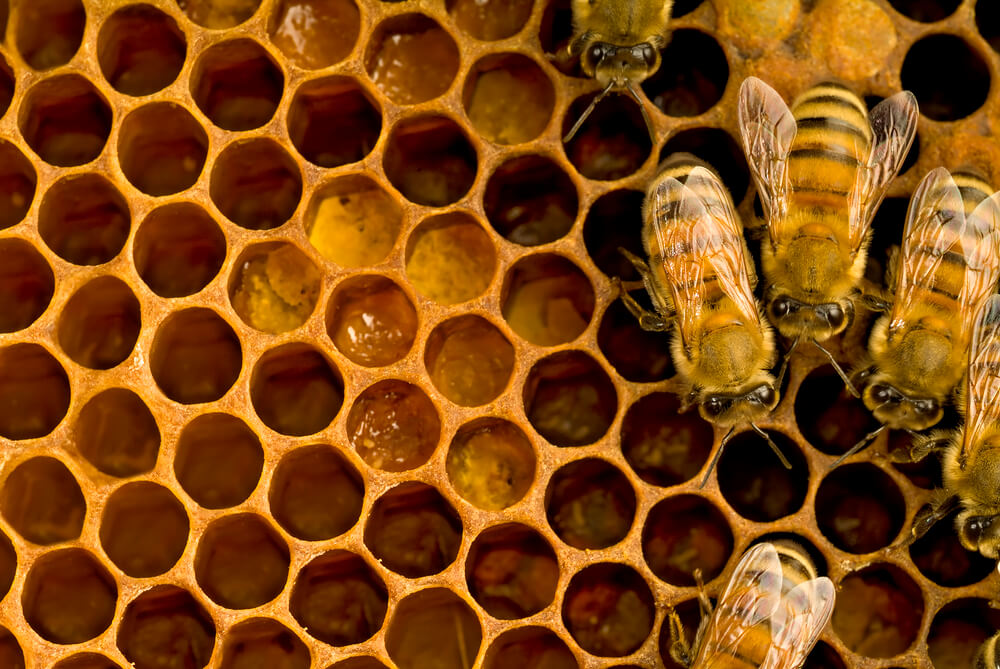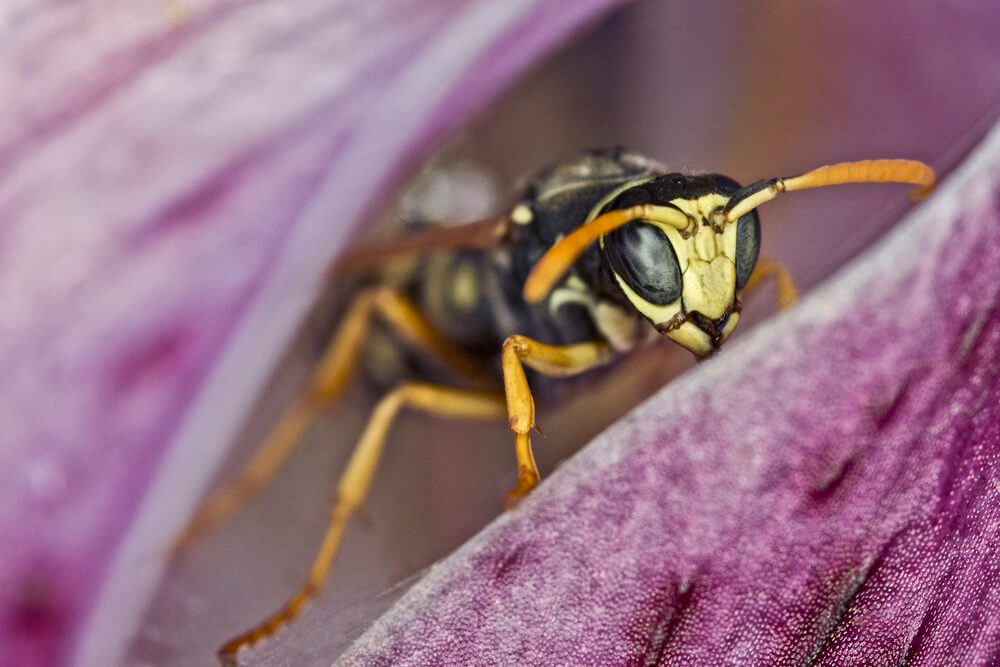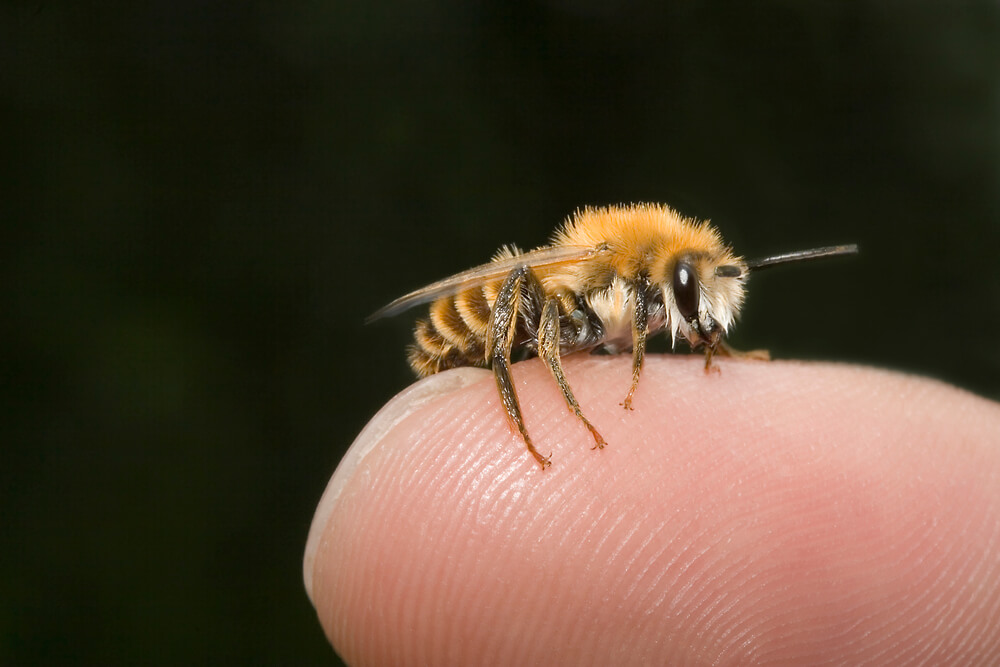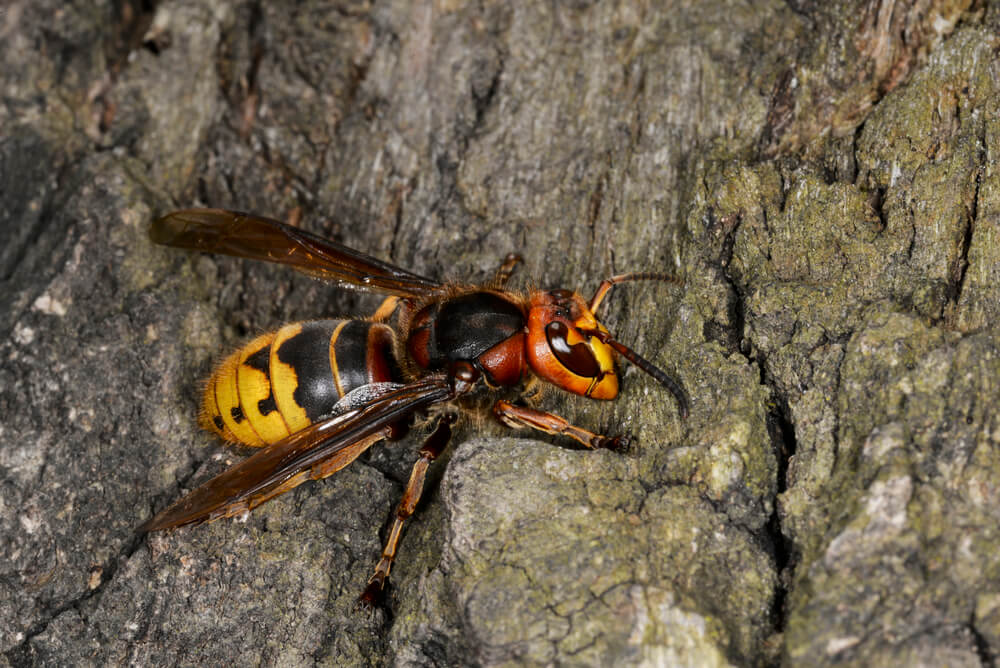Table of Contents:
How Do I Know if it’s a Wasp or Bees Nest?

Wasp nests are the most common nests that people find. You’ll typically see them under your home’s carport, porch, shed, or other eaves.
But here’s the kicker:
Bees and wasps are beneficial creatures that are vital to our ecosystems.
For instance, wasps provide wonderful pest control for our food crops by eating bugs like whiteflies and caterpillars. Without wasps, our planet could be over-infested with spiders and other bugs.
And as for bees?
We can thank them for nearly 1 in 3 bites of food we eat. Crops like cherries, apples, cranberries, blueberries, and almonds need bees for pollination.(1, 2)
With that said, there are easy ways to remove wasp and bee nests without harming them. More on that later.
Now let’s discuss the most common kinds of wasp and bee nests:
- Honeybees
- Carpenter bees
- Bumblebees
- Mud dauber wasps
- Paper wasps
- Bald-faced hornets
Honeybee Nest:

Honeybees are social bees that live in big family units with a queen, drones (males), and workers (females). Honeybee colonies are big, containing anywhere between 10,000 to 60,000 honeybees.
Honeybees usually nest in empty holes inside trees. Occasionally, honeybees will also create their nests in open cavities around your home.
Unlike hornets or wasps, honeybee colonies will survive the winter by clustering together to remain warm. Since they can withstand colder weather, honeybees won’t abandon their nests in the fall like wasps do.
To remove honeybee nests:
Contact a local beekeeper to safely relocate the nest without hurting them. Most beekeepers will handle them for free. Honeybees are vital pollinators responsible for one in every three bites of food we eat.
Carpenter Bee Nest:

Carpenter bees are solitary bees that live alone. Female carpenter bees build their nests by drilling into wood surfaces like decks, porches, and sheds.
Carpenter bees prefer unpainted, weathered wood. They especially like softer varieties such as cedar, cypress, redwood, and pine. Pressure-treated or painted wood is much less likely to be used by carpenter bees.
To remove carpenter bee nests:
Read our guide on How to Get Rid of Carpenter Bees Without Hurting Them. Carpenter bees are vital pollinators that should be protected.
Bumblebee Nest:
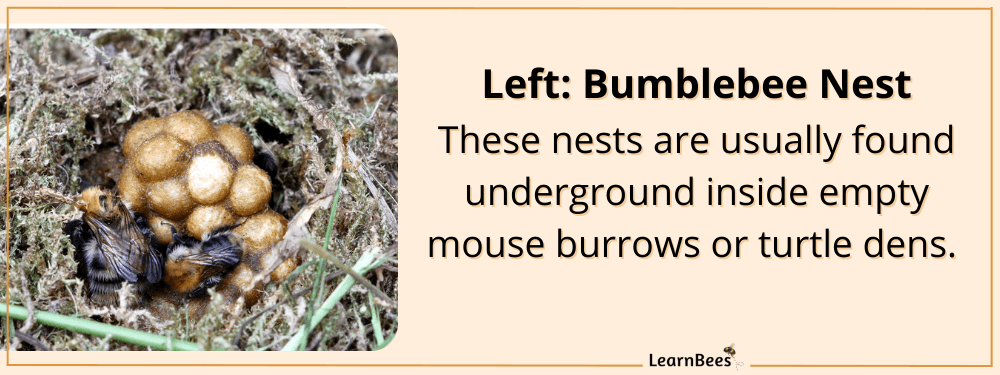
Bumblebees are social insects that live in colonies with other bumblebees. Bumblebee colonies include a queen bumblebee, a few drones (males), and many workers (females).
Bumblebees often nest in pre-existing cavities like empty rock burrows, mouse holes, or turtle dens.
Bumblebee colonies are much smaller than honeybee colonies – with typically only 50-400 bees in a single nest. It’s best to leave their nests alone because they’re gentle bees that aren’t likely to sting.
To remove bumblebee nests:
Do not disturb bumblebee nests. Bumblebees are crucial pollinators that have declined over the past several years. Destruction of their nests can accelerate their extinction.
Bumblebees are annual bees, meaning the colony only survives one year. Once the fall arrives, the colony begins to die off, and the nest will be abandoned.
Mud Dauber Wasp Nest:

Mud dauber nests are created with, you guessed it, mud. They typically make their nests under shelters, like barns, sheds, and porches.
Mud daubers are solitary wasps that live by themselves. They leave humans alone unless they’re seriously provoked.
Female mud daubers survive the cold months by hibernating while male mud daubers die off. As a result, mud dauber nests will be abandoned by late autumn.
To remove mud dauber nests:
Mud daubers are gentle wasps that won’t go out of their way to sting you. They’re active during the spring, summer, and early fall.
By the time late fall rolls around, mud daubers will abandon their nests. We recommend only knocking down their nests once they’re abandoned since mud daubers are avid pollinators.
Paper Wasp Nest:

Paper wasps’ nests famously resemble upside-down umbrellas. They’re grayish-brown with several small holes in them.
Paper wasps build their nests with wood fiber gathered from plants, which the wasps chew to create paper-like, hexagonal cells.
Their colonies aren’t very large, typically with less than 100 adult wasps per colony.(3)
Before the winter arrives, the bulk of the paper wasp colony will die. As such, they abandon their nests, and you can safely knock them down.
To remove paper wasp nests:
Paper wasps abandon their nests by late fall, so we recommend waiting until then to remove them. Paper wasps are crucial pollinators that should be left alone. Once fall arrives, you can knock down their old nests with a broom or stick.
Bald-Faced Hornet Nest:

Bald-faced hornets mostly nest in trees, usually 10+ feet above the ground. Bald-faced hornet nests can be basketball sized or larger.
Hornets build their nests by chewing wood fibers to form a gray paper-like material. They live in colonies with 100-500 other hornets.
Like other wasps, bald-faced hornet colonies will start dying off before colder weather comes. As such, their nests will be abandoned.(4)
To remove bald-faced hornet nests:
Bald-faced hornets are large, stinging creatures that can be very protective over their nests. We do not recommend disturbing their nest. Instead, wait until they abandon their nests in the late fall then you can safely remove them.
Should I Remove a Bees Nest?
In most cases, no. It’s best to leave the bees alone.
The only exceptions are if the bee’s nest is inside or near your home, where it could be disturbed by people or pets. In this case, call a local beekeeper to help rescue the nest and save the bees. Most beekeepers do this for free.
Remember:
Bees are valuable insects that help pollinate many of the crops we eat. We need them for our survival.
Additionally, most bee species are gentle and won’t go out of their way to hurt you. Bees get a bad rap, but they actually do well when they’re simply left alone. For example, I feel safe gardening next to flowers full of pollinating bees.
The bees are calm because they’re away from their nests which means they have nothing to protect. They’re simply out collecting pollen and nectar for food.
Who Do I Call to Remove a Bees Nest?
If you must remove a bee’s nest, your best bet is to call a local beekeeper. They’ll be able to safely rescue the nest and find a new home for the bees.
It’s important to relocate the bees without harming them because they play a vital role in our ecosystem. Additionally, many beekeepers are more than happy to come and remove a nest for free.
Avoid calling pest control because most pest control companies will kill the bees.
FAQs on Bees Nest
- How do I know if it’s a wasp or bee nest?
- How do I know what kind of bee’s nest I have?
- What is the difference between a bee hive and a bee nest?
- What are the different types of bee nests?
- How do you destroy a bee’s nest?
- What do you do about a bee’s nest?
- What time of year do bees nest?
- Will a bee’s nest go on its own?
- Where do bees go at night?
- How many bees live in a nest?
- What happens if you block the entrance to a bee’s nest?
- When should you knock down a bee’s nest?
- Should I leave a bee’s nest alone?
- How do you get rid of a bee’s nest without getting stung?
How do I know if it’s a wasp or bee nest? How do you tell if you have a bee’s nest?
The best way to identify a bee’s nest is to read our guide here.
There are more than 20,000 bee species, so their nests look different depending on the type of bee.
—> Go back to the FAQs on bees nest
More to Explore:
How do I know what kind of bee’s nest I have?
The most common bee nest people encounter is usually honeybee nests or carpenter bee nests. You can identify them by reading our guide here.
—> Go back to the FAQs on bees nest
More to Explore:
What is the difference between a bee hive and a bee nest?
Although beehive and bee nests are often used interchangeably, they actually mean something different.
Bee nests are naturally occurring structures that bees build themselves out of wax, leaves, or mud. A beehive is a man-made structure where beekeepers keep bees.
—> Go back to the FAQs on bees nest
More to Explore:
What are the different types of bee nests?
There are many different types of bee nests because there are thousands of different bee species.
For example, carpenter bee nests are drilled into wooden structures like decks and porches. Honeybee nests are large structures made of wax, typically found in trees. Other bee species, like sweat bees, nest underground in tiny holes they drill.
—> Go back to the FAQs on bees nest
More to Explore:
How do you destroy a bee’s nest?
You should not destroy bees’ nests because bees are beneficial insects that pollinate our nation’s crops. Food crops like squash, pumpkins, melons, apples, almonds, and blueberries all depend on bees for pollination.
If you must remove a bee’s nest, your best bet is to call a local beekeeper. They’ll be able to safely rescue the nest and find a new home for the bees.
Don’t call pest control because most pest control companies will kill the bees.
—> Go back to the FAQs on bees nest
More to Explore:
What do you do about a bee’s nest?
Bees are gentle insects that should be left undisturbed. They will not go out of their way to sting you unless you start poking around their nests.
Additionally, most bees’ nests are annual nests that will be abandoned by the late fall. For example, bumblebees and carpenter bees will leave their nests before the cold weather arrives.
Honeybees are the exception. Honeybees overwinter together in their nests, so you’ll need to call a local beekeeper to relocate a honeybee nest.
—> Go back to the FAQs on bees nest
More to Explore:
What time of year do bees nest? How long do bees nest for?
Bees are cold-blooded insects that thrive in warm weather. So bees nest and remain the most active during the spring, summer, and early fall. Once the winter arrives, the bees will either hibernate or become dormant.
—> Go back to the FAQs on bees nest
More to Explore:
Will a bee’s nest go on its own?
It depends on the bee species.
In most cases, the bees will abandon the nest before winter arrives. Carpenter bees and bumblebees, for instance, will mostly die off before the weather gets cold.
The exception is honeybees. Honeybee nests don’t go away on their own because honeybees overwinter by staying warm in a tight cluster. To remove a honeybee nest, you’ll need to call a local beekeeper to relocate the honeybees. Fortunately, most beekeepers will relocate honeybee nests for free.
—> Go back to the FAQs on bees nest
More to Explore:
- Ground Bees: Are They a Threat to Your Yard?
- Wasps vs. Honeybees: Are They Different?
- Do Bumble Bees Bite?
Where do bees go at night?
Bees go back to their nests at night, where they either sleep or perform more work around the nest.
—> Go back to the FAQs on bees nest
More to Explore:
How many bees live in a nest?
It depends on the type of bee.
For example, bumblebee nests usually hold between 50-400 bumblebees. Honeybee nests can be much larger, holding up to 60,000 honeybees.
But not all bees live in colonies. In fact, most bees are solitary bees that live by themselves. For instance, carpenter bees, mason bees, and sweat bees all live alone.
—> Go back to the FAQs on bees nest
More to Explore:
- Do Carpenter Bees Pollinate?
- How Long Do Bumble Bees Live?
- Honeybees vs. Bumblebees: How Do They Compare?
What happens if you block the entrance to a bee’s nest?
You should not block the entrance to a bee’s nest because you can kill the bees. Bees should be left alone because they’re vital pollinators that help our world’s food supply. It’s estimated that bees are responsible for one in every three bites of food we eat.
—> Go back to the FAQs on bees nest
More to Explore:
- Do Queen Bees Eat Honey?
- Are Worker Bees Male or Female?
- Queen Bee Versus Worker Bees – How Do They Compare?
When should you knock down a bee’s nest?
You can remove a bee’s or wasp’s nest in the wintertime once the nest has been abandoned. That said, the best thing to do is leave the bee’s nest alone or call a local beekeeper to relocate it for free.
—> Go back to the FAQs on bees nest
More to Explore:
Should I leave a bee’s nest alone? What happens if you destroy a bee’s nest?
Yes, you should leave a bee’s nest alone as long as it’s not near people or pets. Bees are passive-natured insects that will only sting humans if they feel threatened directly. You should be fine in most cases if you give them space around their nests.
Additionally, bees are essential pollinators that help our food supply. Without bees, our world’s crops would be greatly diminished.
—> Go back to the FAQs on bees nest
More to Explore:
How do you get rid of a bee’s nest without getting stung?
The best thing to do is leave the bees alone. Despite popular belief, bees are gentle insects that don’t attack for no reason. The bees will not bother you if you give them space away from their nests.
Also, most bee nests will be abandoned by the late fall because bees aren’t active during the winter.
The exception is honeybees. Honeybees will remain in their nests over the winter. So if you need to remove a honeybee nest, contacting a beekeeper is best. A beekeeper will move the nest without harming them. The good news is that most beekeepers will remove bees’ nests for free.
